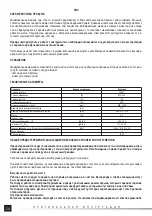
17
O R I G I N A L I N S T R U C T I O N S
GB
If there are no signs of malfunction, you can adjust the speed and start working.
Working with the Sander
Where required, the material to be worked must be secured in such a way that it cannot move during work; use vices or clamps,
etc. The sanding disc rotates at a high speed and, if not properly secured, the material may move uncontrollably during work,
which would increase the risk of serious injury.
Wear personal protective equipment, such as sight and hearing protection, a dust mask, safety gloves and appropriate work
clothing.
Make sure you carry out all assembly and adjustment steps.
Make sure that the switch is in the OFF position, then plug the power cord into the wall outlet.
Always hold the sander with both hands gripping its front and rear handles. If the extension arm is used, grip the rear handle and
the extension arm handle.
Allow the sander to reach full speed and only then start working the material.
When you fi nish work, use the power switch to turn the sander off , unplug it from the mains by pulling the power cord out of the
socket, and start maintenance works.
Sander Operation Guidelines
It is forbidden to hold the sander in any other way but by the handle grips. Do not hold the sander by any parts of the housing
other than the handle grips.
Do not press the sander against the surface too hard. Excessive pressure can cause the sander to overheat and damage the
worked surface.
Position the sander so that the entire surface of the sanding sheet is used. This will ensure uniform wear of the sheet.
Move the sander towards and away from you, and gradually to a side. Do not move the sander in circles. Wood should be sanded
along the grain. Sanding should be started with thicker grain sheets, and then use increasingly fi ner grain sheets until the desired
eff ect is achieved. Avoid checking the condition of the wood surface worked with your bare hand. This can cause injury from
splinters and burrs generated during work.
The sander features two areas from which dust is transported to the dust extraction system. One area is the holes in the lower side
of the work head, and the other one is a gap between the edge of the work head and the guard. The dust extraction force must be
selected experimentally during operation. The greatest force will not always be the most eff ective. The airfl ow generated during
operation may cause the sander to suck too much to the ground surface, which will make it diffi cult for dust to move towards the
holes in the disc or its edges, and reduce the performance. If the extraction force is too low, the dust generated during operation
will stay on the material.
The tool speed and sheet grades must be selected according to the surface worked. Too high grade of the sanding sheet will
produce scratches on the surface of the material.
Higher speeds should be used for sanding ceramic materials and non-resinous wood. Resin wood should be sanded at a lower
speed. If the speed is too high, the resin in the wood will heat up quickly and the sanding sheet will be stuck in place. For a similar
reason, sanding paints and varnishes should also be carried out at a lower speeds.
Take regular breaks during operation to check the condition of the sanding sheet and the fi ll-up level of the dust extraction system.
If a sanding sheet is found to have been clogged with dust generated during operation, or that the abrasive grain has worn, replace
the sheet with a new one.
TOOL MAINTENANCE
NOTE! Before carrying out any adjustment, servicing or maintenance work, unplug the tool from the power outlet.
The Disc Head allows you to remove the disc to clean the space between the disc and the drive guard thoroughly. Hold the disc
with your hand, then use the wrench to loosen the disc retaining screw (XII). Clean the space between the disc, the disc itself and
the guard of dust and other contaminants with a soft dry cloth, a jet of compressed air at a max. pressure of 0.3 MPa, or a soft
brush. Do not use sharp objects for cleaning.
After you have fi nished working the material, check the technical condition of the power tool visually and evaluate the body and
handle grips, electric cord with plug and bend protection grommet, the operation of the electric switch, the ventilation openings for
blockages, brush sparking, the noise level of bearings and gearbox, start-up and smoothness of operation. During the warranty
period, the user is not allowed to install any power tools or replace any components or parts, as this will result in the loss of war-
ranty rights. Any irregularities found during the check or the operation signal the need for repair to be done at the servicing centre.
After work has been fi nished, clean the housing, ventilation slots, switches, additional handle grip and guards using e.g. a jet of
air (pressure not more than 0.3 MPa), or a brush or dry cloth without the use of chemicals or cleaning liquids. Clean the tools and
handles with a dry, clean cloth.






























